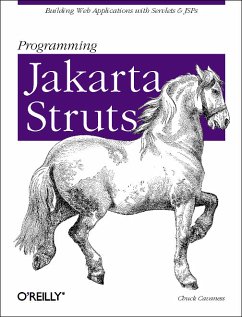Web tier frameworks have really taken off in the past year or so. Developers who used to spend hours and hours writing low-level features have realized the enormous benefits of using well-written frameworks to build the presentation tier so they can get to coding the "good stuff", the business logic at the core of the program.
The Struts Framework, originally created by Craig R. McClanahan and donated to the Apache Software Foundation's Jakarta project in 2000, has become one of the most popular presentation frameworks for building web applications with Java Servlet and JavaServer Pages (JSP) technology. It encourages application architecture based on the Model-View-Controller (MVC) design paradigm, colloquially known as the Model 2 approach.
As popular as Struts is becoming, the online documentation is inadequate, focusing on the most basic functionality and leaving out information crucial to developers writing today's complex web applications. O'Reilly's Programming Jakarta Struts was written by Chuck Cavaness after his internet company decided to adopt the framework, then spent months really figuring out how to use it to its fullest potential. He calls the books, "the culmination of lessons learned (the hard way) during the building of our application."
Readers will benefit from the real-world, "this is how to do it" approach Cavaness takes to developing complex enterprise applications using Struts, and his focus on the 1.1 version of the Framework makes this the most up-to-date book available.
Programming Jakarta Struts covers:
* An overview of the concepts involved in writing web applications
* Detailed installation and configuration instructions to get Struts up and running quickly
* A thorough discussion of how Struts implements the Model-View-Controller pattern, and how to interface with that pattern in your own applications
* JSP and Jakarta Tag Libraries for authoring complex web pages
* Logging, Validation, and Exception Handling with Struts
* Using the new Struts template framework, Tiles.
* Writing internationalization and localization code using Struts
* Practical, real-world best practices for web applications
Craig McClanahan, originator of Struts, says of the book, "One thing a lot of open source packages lack is a comprehensive guide to all of the features -- something that goes far enough past "hello, world" to get you into solving real application design problems, and it looks like you've hit just the right level for a lot of people."
The Struts Framework, originally created by Craig R. McClanahan and donated to the Apache Software Foundation's Jakarta project in 2000, has become one of the most popular presentation frameworks for building web applications with Java Servlet and JavaServer Pages (JSP) technology. It encourages application architecture based on the Model-View-Controller (MVC) design paradigm, colloquially known as the Model 2 approach.
As popular as Struts is becoming, the online documentation is inadequate, focusing on the most basic functionality and leaving out information crucial to developers writing today's complex web applications. O'Reilly's Programming Jakarta Struts was written by Chuck Cavaness after his internet company decided to adopt the framework, then spent months really figuring out how to use it to its fullest potential. He calls the books, "the culmination of lessons learned (the hard way) during the building of our application."
Readers will benefit from the real-world, "this is how to do it" approach Cavaness takes to developing complex enterprise applications using Struts, and his focus on the 1.1 version of the Framework makes this the most up-to-date book available.
Programming Jakarta Struts covers:
* An overview of the concepts involved in writing web applications
* Detailed installation and configuration instructions to get Struts up and running quickly
* A thorough discussion of how Struts implements the Model-View-Controller pattern, and how to interface with that pattern in your own applications
* JSP and Jakarta Tag Libraries for authoring complex web pages
* Logging, Validation, and Exception Handling with Struts
* Using the new Struts template framework, Tiles.
* Writing internationalization and localization code using Struts
* Practical, real-world best practices for web applications
Craig McClanahan, originator of Struts, says of the book, "One thing a lot of open source packages lack is a comprehensive guide to all of the features -- something that goes far enough past "hello, world" to get you into solving real application design problems, and it looks like you've hit just the right level for a lot of people."

